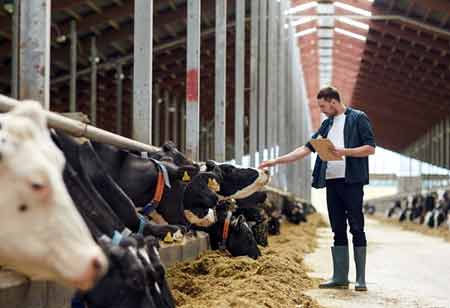Thank you for Subscribing to Agri Business Review Weekly Brief
Reviving the Dairy Industry with the Internet of Things
Dairy farming is regarded as one of agriculture's fundamental functions for the long-term production of milk.

By
Agri Business Review | Wednesday, May 24, 2023
Stay ahead of the industry with exclusive feature stories on the top companies, expert insights and the latest news delivered straight to your inbox. Subscribe today.
Farming is becoming more efficient and profitable through new-age smart techniques using IoT devices for increased milk production, advanced cattle health monitoring, and anomaly detection.
FREMONT, CA: Dairy farming is regarded as one of agriculture's fundamental functions for the long-term production of milk. Large-scale dairies use cutting-edge and creative technologies to automate the milking process and maintain the health parameters of the animals. Today, dairy farmers emphasize precision agriculture more by monitoring and establishing a database for information provisioning and obtaining market data from competitors.
The Internet of Things (IoT) substantially impacts milk production. Technological advances are needed to boost the global milk supply to meet the demands of a growing population. Farmers may expand and improve various dairy-related operations with this technology, such as determining the optimal time to milk cows, extending the shelf life of milk, etc.
IoT plays a crucial role in monitoring resources in dairy farming by connecting multiple and heterogeneous objects, such as buildings, machinery, vehicles, and even living organisms like cattle, in mixed dairy farms (which produce milk from cattle and cultivate feed grain for livestock). The IoT Sensor and Edge Computing (EC) offer resource monitoring and traceability in the value chain, allowing producers to improve processes, provide the origin of the produce, and ensure the quality of the product for consumers.
IoT technology employs several sensors to collect diverse data points and transfer data using little power and bandwidth. Adaptation of smart sensors and techniques (data sensing methods such as pressure sensing, volumetric sensing, sensing schedules, etc.) improves resource efficiency, is eco-friendly, enables transparency and data security, and is conducive to the preservation of the environment. These methods provide a real-time view of the milk levels, monitor the cow's health, manage the warehouse, and ensure safe transportation access.
IoT platforms with integrated AI engines, gateways, LPWA networks, and smart sensors bring about a genuine change in the sector. Many operations are being automated with the help of cutting-edge technology. IoT and data-driven strategies are expanding the potential for intelligent dairy farming. The IoT can assist farmers with wearable sensor devices that inform them of the state of each animal. The sensor-based technology can effectively and accurately detect the cattle's disease before it impacts milk output. IoT provides an essential foundation for cattle breeding by monitoring real-time bovine data such as activity, temperature, and heart rate. This vital information can then be utilized to undertake a comprehensive examination to determine oestrus in cattle. The most exciting benefits of this technology are an increase in milk production, a decrease in labor and medication costs, and an increase in dairy farms' income. Dairy product businesses and animal breeding efforts have also shown considerable interest in this technology.
It is possible to employ IoT and AI-based technological methods to reduce the negative influences and increase the positive elements that affect productivity. For instance, an artificial intelligence (AI) model based on IoT sensors in milking systems can provide data to assist farmers in determining when to milk their calves or modify their feeding patterns. These statistics can be improved to preserve milk quality and better comprehend production. Modern frameworks that include IoT sensors, IoT platforms, and AI solutions should be centered on many areas of smart dairy farming to help farmers enhance milk yield by employing various strategies and innovations.
The technological use of IoT and AI-based approaches facilitate the development of new production (milk yield) and dairy farming processes. Process innovation on a smart dairy farm can vary for distinct sets of activities performed at various levels. On a dairy farm, milking is considered a single procedure; nevertheless, multiple other tasks are undertaken, including feeding, cow monitoring, and milk preservation. IoT can be implemented in various processes and procedures, such as the feed system automatically feeding cows when it detects their hunger. It can also monitor the automatic sensing of heat, which aids in reproduction. By evaluating health and observing cows for disease diagnosis and prevention, the farmer can identify any animals that require veterinary care.
Smart dairy farming comprises real-time sensors that collect data from cows using wearable smart collars, machine learning data processing, and cloud-based data centers that support the farmer in managing the quality of dairy products.





